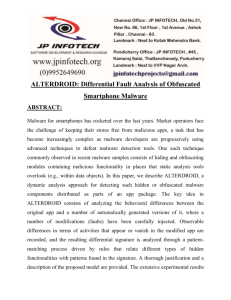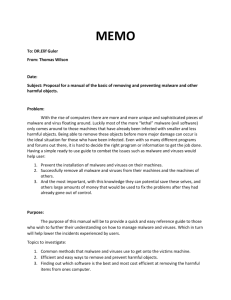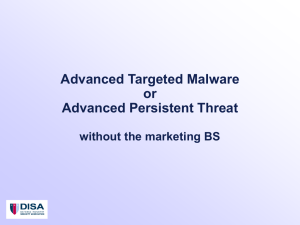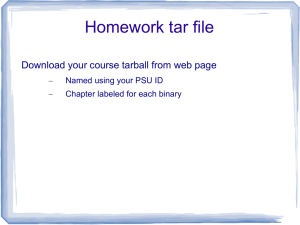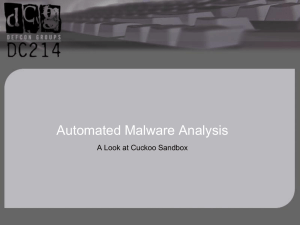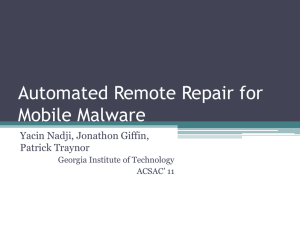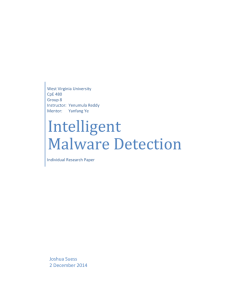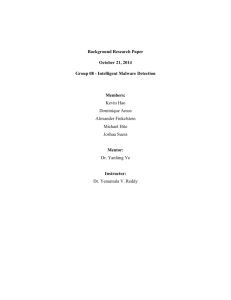Report 2 - People at VT Computer Science
advertisement
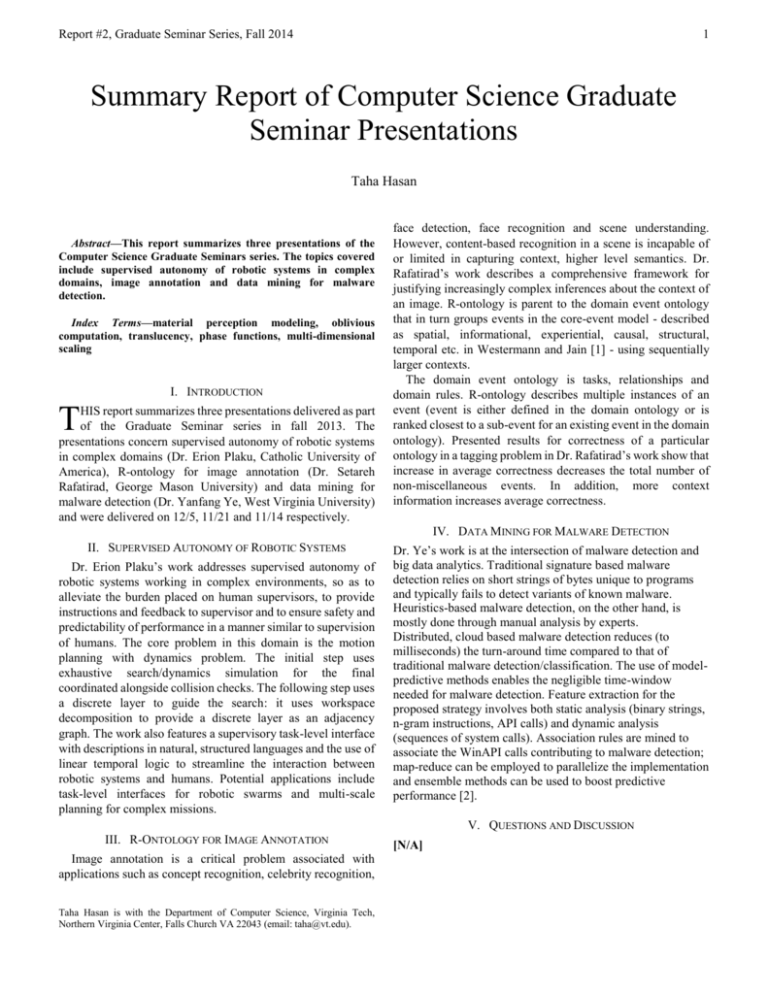
Report #2, Graduate Seminar Series, Fall 2014 1 Summary Report of Computer Science Graduate Seminar Presentations Taha Hasan Abstract—This report summarizes three presentations of the Computer Science Graduate Seminars series. The topics covered include supervised autonomy of robotic systems in complex domains, image annotation and data mining for malware detection. Index Terms—material perception modeling, oblivious computation, translucency, phase functions, multi-dimensional scaling I. INTRODUCTION T HIS report summarizes three presentations delivered as part of the Graduate Seminar series in fall 2013. The presentations concern supervised autonomy of robotic systems in complex domains (Dr. Erion Plaku, Catholic University of America), R-ontology for image annotation (Dr. Setareh Rafatirad, George Mason University) and data mining for malware detection (Dr. Yanfang Ye, West Virginia University) and were delivered on 12/5, 11/21 and 11/14 respectively. face detection, face recognition and scene understanding. However, content-based recognition in a scene is incapable of or limited in capturing context, higher level semantics. Dr. Rafatirad’s work describes a comprehensive framework for justifying increasingly complex inferences about the context of an image. R-ontology is parent to the domain event ontology that in turn groups events in the core-event model - described as spatial, informational, experiential, causal, structural, temporal etc. in Westermann and Jain [1] - using sequentially larger contexts. The domain event ontology is tasks, relationships and domain rules. R-ontology describes multiple instances of an event (event is either defined in the domain ontology or is ranked closest to a sub-event for an existing event in the domain ontology). Presented results for correctness of a particular ontology in a tagging problem in Dr. Rafatirad’s work show that increase in average correctness decreases the total number of non-miscellaneous events. In addition, more context information increases average correctness. IV. DATA MINING FOR MALWARE DETECTION II. SUPERVISED AUTONOMY OF ROBOTIC SYSTEMS Dr. Erion Plaku’s work addresses supervised autonomy of robotic systems working in complex environments, so as to alleviate the burden placed on human supervisors, to provide instructions and feedback to supervisor and to ensure safety and predictability of performance in a manner similar to supervision of humans. The core problem in this domain is the motion planning with dynamics problem. The initial step uses exhaustive search/dynamics simulation for the final coordinated alongside collision checks. The following step uses a discrete layer to guide the search: it uses workspace decomposition to provide a discrete layer as an adjacency graph. The work also features a supervisory task-level interface with descriptions in natural, structured languages and the use of linear temporal logic to streamline the interaction between robotic systems and humans. Potential applications include task-level interfaces for robotic swarms and multi-scale planning for complex missions. Dr. Ye’s work is at the intersection of malware detection and big data analytics. Traditional signature based malware detection relies on short strings of bytes unique to programs and typically fails to detect variants of known malware. Heuristics-based malware detection, on the other hand, is mostly done through manual analysis by experts. Distributed, cloud based malware detection reduces (to milliseconds) the turn-around time compared to that of traditional malware detection/classification. The use of modelpredictive methods enables the negligible time-window needed for malware detection. Feature extraction for the proposed strategy involves both static analysis (binary strings, n-gram instructions, API calls) and dynamic analysis (sequences of system calls). Association rules are mined to associate the WinAPI calls contributing to malware detection; map-reduce can be employed to parallelize the implementation and ensemble methods can be used to boost predictive performance [2]. V. QUESTIONS AND DISCUSSION III. R-ONTOLOGY FOR IMAGE ANNOTATION Image annotation is a critical problem associated with applications such as concept recognition, celebrity recognition, Taha Hasan is with the Department of Computer Science, Virginia Tech, Northern Virginia Center, Falls Church VA 22043 (email: taha@vt.edu). [N/A] Report #2, Graduate Seminar Series, Fall 2014 REFERENCES [1] [2] Westermann, Utz, and Ramesh Jain. "Events in multimedia electronic chronicles (e-chronicles)." International Journal on Semantic Web and Information Systems (IJSWIS) 2.2 (2006): 1-23. Ye, Yanfang, et al. "Automatic malware categorization using cluster ensemble."Proceedings of the 16th ACM SIGKDD international conference on Knowledge discovery and data mining. ACM, 2010. 2


